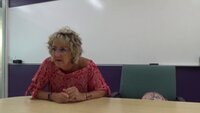| Title |
Wilkerson, Sue OH19_099 |
| Creator |
Weber State University, Stewart Library: Oral History Program. |
| Contributors |
Wilkerson, Sue, Interviewee; Langsdon, Sarah Interviewer & Video Technician |
| Description |
The Beyond Suffrage Project was initiated to examine the impact women have had on northern Utah. Weber State University explored and documented women past and present who have influenced the history of the community, the development of education, and are bringing the area forward for the next generation. The project looked at how the 19th Amendment gave women a voice and representation, and was the catalyst for the way women became involved in the progress of the local area. The project examines the 50 years (1870-1920) before the amendment, the decades to follow and how women are making history today. |
| Abstract |
The following is an oral history interview with Sue Wilkerson, conducted on September 5, 2019, in the Stewart Library, at Weber State University, by Sarah Langsdon. In this interview, Sue discusses her life, her memories, and the impact of the 19th Amendment.; The following is a video clip of an oral history interview with Sue Wilkerson, conducted on September 5, 2019. In this video clip, Sue discusses her experiences as a commercial driver. |
| Image Captions |
Sue Wilkerson 5 September 2019; Sue Wilkerson speaking about her experiences as a commercial driver. |
| Subject |
Voting--United States; Women--suffrage; Women--Rights of women |
| Keywords |
19th Amendment; Voting rights; Women's rights |
| Digital Publisher |
Stewart Library, Weber State University, Ogden, Utah, United States of America |
| Date |
2019 |
| Date Digital |
2019 |
| Temporal Coverage |
1961; 1962; 1963; 1964; 1965; 1966; 1967; 1968; 1969; 1970; 1971; 1972; 1973; 1974; 1975; 1976; 1977; 1978; 1979; 1980; 1981; 1982; 1983; 1984; 1985; 1986; 1987; 1988; 1989; 1990; 1991; 1992; 1993; 1994; 1995; 1996; 1997; 1998; 1999; 2000; 2001; 2002; 2003; 2004; 2005; 2006; 2007; 2008; 2009; 2010; 2011; 2012; 2013; 2014; 2015; 2016; 2017; 2018; 2019 |
| Medium |
oral histories (literary genre) |
| Spatial Coverage |
San Jose, Santa Clara, California, United States, https://sws.geonames.org/5392171, 37.33939, -121.89496; Ogden, Weber, Utah, United States, https://sws.geonames.org/5779206, 41.223, -111.97383 |
| Type |
Text; Image/StillImage; Image/MovingImage |
| Access Extent |
44 page PDF; Video clip is an mp4 file, 163 MB |
| Conversion Specifications |
Filmed using a Sony HDR-CX430V digital video camera. Sound was recorded with a Sony ECM-AW3(T) bluetooth microphone. Transcribed using Express Scribe Transcription Software Pro 6.10 Copyright NCH Software. |
| Language |
eng |
| Rights |
Materials may be used for non-profit and educational purposes, please credit University Archives; Weber State University; Music from Uppbeat (free for Creators!): https://uppbeat.io/t/yeti-music/gentle-breeze; License code: IWGKRYG7XHQOMZY0; Music from Uppbeat (free for Creators!): https://uppbeat.io/t/simon-folwar/hope; License code: KYI5VLB63GF1TXND |
| Source |
Wilkerson, Sue OH19_099 Weber State University Archives |
| Format |
application/pdf; video/mp4 |
| ARK |
ark:/87278/s6n4rwsm |
| Setname |
wsu_bs_oh |
| ID |
105509 |
| Reference URL |
https://digital.weber.edu/ark:/87278/s6n4rwsm |
| Title |
Wilkerson, Sue OH19_100 |
| Creator |
Weber State University, Stewart Library: Oral History Program. |
| Contributors |
Wilkerson, Sue, Interviewee; Langsdon, Sarah Interviewer & Video Technician |
| Description |
The Beyond Suffrage Project was initiated to examine the impact women have had on northern Utah. Weber State University explored and documented women past and present who have influenced the history of the community, the development of education, and are bringing the area forward for the next generation. The project looked at how the 19th Amendment gave women a voice and representation, and was the catalyst for the way women became involved in the progress of the local area. The project examines the 50 years (1870-1920) before the amendment, the decades to follow and how women are making history today. |
| Abstract |
The following is an oral history interview with Sue Wilkerson, conducted on September 5, 2019, in the Stewart Library, at Weber State University, by Sarah Langsdon. In this interview, Sue discusses her life, her memories, and the impact of the 19th Amendment. |
| Image Captions |
Sue Wilkerson 5 September 2019 |
| Subject |
Voting--United States; Women--suffrage; Women--Rights of women |
| Keywords |
19th Amendment; Voting rights; Women's rights |
| Digital Publisher |
Stewart Library, Weber State University, Ogden, Utah, United States of America |
| Date Digital |
2019 |
| Temporal Coverage |
1961; 1962; 1963; 1964; 1965; 1966; 1967; 1968; 1969; 1970; 1971; 1972; 1973; 1974; 1975; 1976; 1977; 1978; 1979; 1980; 1981; 1982; 1983; 1984; 1985; 1986; 1987; 1988; 1989; 1990; 1991; 1992; 1993; 1994; 1995; 1996; 1997; 1998; 1999; 2000; 2001; 2002; 2003; 2004; 2005; 2006; 2007; 2008; 2009; 2010; 2011; 2012; 2013; 2014; 2015; 2016; 2017; 2018; 2019 |
| Medium |
oral histories (literary genre) |
| Spatial Coverage |
San Jose, Santa Clara, California, United States, https://sws.geonames.org/5392171, 37.33939, -121.89496; Ogden, Weber, Utah, United States, https://sws.geonames.org/5779206, 41.223, -111.97383 |
| Type |
Text; Image/StillImage |
| Access Extent |
44 page PDF |
| Language |
eng |
| Rights |
Materials may be used for non-profit and educational purposes, please credit University Archives; Weber State University |
| Source |
Wilkerson, Sue OH19_099 Weber State University Archives |
| Format |
application/pdf |
| Setname |
wsu_bs_oh |
| ID |
105707 |
| Reference URL |
https://digital.weber.edu/ark:/87278/s6n4rwsm/105707 |





